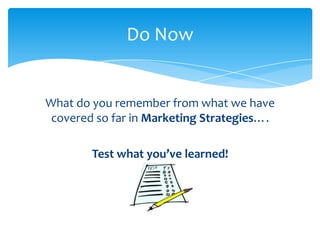
3.9 selecting marketing strategies - moodle
- 1. Do Now What do you remember from what we have covered so far in Marketing Strategies…. Test what you’ve learned!
- 2. Selecting Marketing Strategies Module 1
- 3. Learning Objectives By the end of the lesson you should be able to: 1. Describe a range of marketing strategies. 2. Explain the meaning and significance of Ansoff’s Matrix in assessing marketing strategies. 3. Assess the suitability of Ansoff’s competitive strategies in a given context. 4. Evaluate the method, benefit and drawbacks of entering international markets.
- 4. Marketing Strategies Corporate Goals What are marketing strategies? Marketing Objectives What steps need to be taken before marketing strategies Analysis of the market can be introduced? Marketing strategy
- 5. Low cost Versus Differentiation for firms that operate in both niche and mass markets LOW COST DIFFERENTIATION The purpose is to make one This is the option to go product appear different for the cheaper end of and somehow superior to the market. others in the market. Encouraging customers to Aim is to offer products choose that particular make at a lower price than or model when making competitors. purchase decisions.
- 6. Ansoff’s matrix Igor Ansoff’s matrix shows the main strategic options available to firms. Market Penetration Product Development Market Development Diversification The matric allows managers to discuss strategies to achieve corporate aims. Each carries a different level of risk.
- 7. Ansoff’s Matrix Increasing Risk Product Existing New Market Existing Market Product Penetration Development New Market Diversification Development Increasing Risk
- 8. Market Penetration Target market would consist of existing customers Introduce new product to this market E.g. – Wii Game Wii Console owners
- 9. Benefits? brand loyalty reduce the purchase of substitutes encourage customers to use the product more often
- 10. Market penetration – in action Given America's love of coffee and super-sized portions, it was inevitable that Starbucks should tie the two together in its latest offering: the massive new 'Trenta' cup size, holding 31 US fluid ounces – that's 917ml, or more than one and a half imperial pints – of beverage
- 11. Market Development Market an existing product to a new market Nothing about the product changes E.g. – Wii Game UK Wii Game USA
- 12. Benefits? Risk but security of an established product.
- 13. Market Development – in action Move abroad Topshop to US Primark in Spain Tesco in China
- 14. Product Development Develop a new product to sell to existing customers Could include and add on or extension pack E.g. – Wii Console Wii Fit
- 15. Benefits? Risk but security of its established customers. Drawbacks? May need extensive R&D.
- 16. Product development – in action The sandwich chain Pret A Manger announced a 37% profit increase, boosted by sales of 50,000 porridge pots a week
- 17. Diversification Market a new product to a new market Related or unrelated to previous product E.g. – Apple Ipad New market
- 19. Diversification – in action Nokia In 1990 Nokia made tyres and toilet rolls Mobile Phones
- 20. Getting to know the Ansoff Matrix Decided how Coca- Cola and Nestle have used different growth strategies. Feedback your findings to the rest of the group.
- 21. National or international? When considering marketing strategies, why is it increasing likely that firms will have an international aspect to their plans? What are the benefits of operating on an international scale?
- 22. Carry out research on ‘Entering International Markets’ and look at the benefits and drawbacks to different methods. Prepare to feedback to the rest of the group.
- 23. Assessing the effectiveness of marketing strategies How can firms assess the effectiveness of marketing strategies? Has the strategy helped the business to achieve its marketing objectives and therefore its corporate objectives? Can the strategy be assessed within quadrants within the Ansoff’s matrix – achieved market penetration, product development, market development or diversification?
- 24. Finally Identify and explain three key words from todays lesson.
- 25. Re-cap Learning Objectives You should now be able to: 1. Describe a range of marketing strategies. 2. Explain the meaning and significance of Ansoff’s Matrix in assessing marketing strategies. 3. Assess the suitability of Ansoff’s competitive strategies in a given context. 4. Evaluate the method, benefit and drawbacks of entering international markets.
Hinweis der Redaktion
- Increased market share/ size.Access to new markets and profit.E-commerce has enabled small to medium sized organisations to do this.